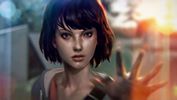Liverpool Sound and Vision Rating 9 out of 10
Life is Strange: Episode 1 – Chrysalis is a third-person episodic adventure game available for download from the PlayStation Store for the PS4. Life is Strange is developed by Dontnod Entertainment who are known for creating games with powerful and dependable female characters that grow and become stronger through the duration of the game, which had been previously released as Remember Me in 2013.
The story revolves around the lead character; an 18 year old girl called Maxine Caulfield, when she returns to her hometown of Arcadia Bay in Oregon following a five year absence in which she resided in Seattle with her family as Max wanted to study photography at Blackwell Academy due to her keen interest in the subject, however she soon discovers that she can rewind time after a series of disturbing events as well as encountering moments of mystery and intrigue along the way.
Max discovers that she can manipulate time by rewinding it in order to use the knowledge she has gained to her advantage. In overcoming a situation by gaining answers to an important question or doing the opposite of the actions previously attempted as the player tries to change the outcome of a bad scenario. Rewinding time can also help guide actions in regards to the choices to make and the consequences of those decisions, whilst it can generally help with puzzles such as realising that there are multiple elements to finding an object involving another item or conversation, therefore rewinding time far enough to get the tools or have a discussion in which to progress. This is an excellent design choice as it means that the standout mechanic of the game is not just a gimmick as it is actually used effectively. It is quite easy to see that a genuine thought process has been invested in taking the time to implement scenarios that would fit well to the time manipulation mechanic.
The Choices feature is quite reminiscent of the My Choices feature found in The Walking Dead episodic games by providing an entire listing of options including the statistical analysis regarding the percentage of players who have made the same choice and those that chose differently for each moral decision with the feature being directly available from the main menu.
There is a form of collectibles that are scattered throughout the episode in which Max can take a photo of a specific event such as a squirrel rather amusingly looking at a beer can pondering quite what it is or a statue with a total of 10 optional photos that the player must be weary of encountering at any given moment within particular areas in order to find them. The optional photos are a positive design choice as it encourages a greater amount of exploration, however it is made even better by how the player can return to any area of the episode in search of the optional photo that may have been missed without it interfering with previously chosen decisions by playing in collectibles mode.
The characters are very unique in their personalities in regards to how they bully other people and having certain behaviour patterns such as being shy, sarcastic, aggressive, knowledgeable, talkative or friendly, while the male and female characters have their own diverse fashion styles that really set them apart in how they look as strong characters emerge throughout the story.
The environment design is excellent as players explore Max’s hometown of Arcadia Bay in Oregon such as Blackwell Academy as well as the surrounding grounds, dorm rooms and much more besides with every area looking distinctly different which is a positive due to the variety of scenery that is provided across the environments.
The performance during remote play is excellent as the graphics, audio and general performance are all at the same level of quality as the PS4 version, while the control scheme has been appropriately optimised resulting in a comfortable control scheme during remote play as moving faster has moved from R2 to the top right of the touch screen, although it would have perhaps been better suited to the R button instead, while tapping the touch pad to open Max’s journal has been mapped to the touch screen and R3 has been mapped to the rear touch pad to re-centre the camera.
The controls are well mapped to the DualShock 4 controller with the control scheme consisting of pressing triangle, O, X or square to perform contextual actions; holding L2 to rewind time while holding R2 to rewind time faster; holding R2 to move faster; pressing R3 to re-centre the positioning of the camera; changing the direction of the left analogue stick to move Max; changing the direction of the right analogue stick to move the camera; pressing the share button takes players to the share feature menu; and pressing the options button to display the pause menu. The touch pad implementation displays Max’s journal by tapping the touch pad, while the light bar implementation remains a light shade of orange throughout gameplay and menus, alongside vibration that is scattered throughout the game for heavy objects falling or loud noises.
The graphics have quite a stylistic approach to rewinding time comprising of such special visual effects as overlapping screen space particles, double exposure and post-processes to create a very unique look that captures the imagination as to exactly what the eyes would see during time travel and time manipulation. While the particle effects during the storms are amazing with lightning, trees and boulders falling down and objects being thrown all around, alongside superb character models with fluent and natural character movements, although the lip syncing does not quite match the voice-overs for the majority of the characters and lines of dialogue.
The presentation of the game is solid with a great user interface across various menus such as the main menu, episodes, help and options, additional content and gameplay menus with support for navigation via the left analogue stick, directional pad and face buttons, although it does not include support for navigation via the right analogue stick and touch pad. The background of the menu screens is of beautiful, picturesque scenery as a town is situated next to the coast line with foliage gently swaying in the wind as a flock of birds fly in the sky and the sun shines upon the sea.
The voice-over cast deliver exceptional performances with realistic dialogue to the age range of each character which, if anything, makes each of the characters even more diverse rather than too serious during light hearted moments or one dimensional. The voice-over cast includes Hannah Telle delivering an amazing performance as the lead character Maxine Caulfield, having previously voiced Iris Campbell and Rose Campbell in Murdered: Soul Suspect, while Ashly Burch, who voices Chloe Price, has also voiced Ayla in Awesomenauts, Tiny Tina in Borderlands 2, Kiki DeWynter, demons and husks in Saints Row: Gat Out of Hell and star of Hey Ash, Whatcha Playin’, alongside former X Factor U.S.A. finalist Dani Knights who voices Victoria Chase and Derek Phillips who previously voiced Lord Treavor Pendleton in Dishonored and Officer Scott and Kurt Wehlander in Murdered: Soul Suspect, voices Max’s photography teacher Mark Jefferson.
The sound effects include Max as well as other characters walking, running and generally interacting with their surroundings and nearby people, while there is a lot of ambience such as a howling wind, storms, birds and seagulls, the amazing soundtrack consists of hand picked indie music from rock to melodic acoustic ballads which perfectly set the tone and atmosphere of the scenes they accompany. From artists such as Mogwai, alt-J, José González, Sparklehorse and Bright Eyes, the music in enhanved by the score composed by Jonathan Morali of Syd Matters. There is no DualShock 4 speaker implementation which is surprising as it could have produced voice-overs, sound effects, ambient sound effects or music to provide a further layer of audio.
The trophy list for the first episode includes 12 bronze with the complete trophy list featuring 61 trophies with 59 bronze, 1 gold and 1 platinum trophy. The trophies are all pretty simple for the first episode as long as players know the mechanics of the game as they have to take 10 optional photos which will provide 11 trophies such as the Wide Angles bronze trophy for taking optional photo #2 of the statue in the middle of the fountain outside the main campus, while the remaining Chrysalis bronze trophy is awarded for completing the first episode. It is estimated that depending upon skill and a good trophy guide to provide some helpful tips that it would take between 2 to 3 hours to 100% the first episode and 10 to 15 hours to platinum the trophy list.
There are no difficulty levels, but there is a rather fitting difficulty curve as there are plenty of puzzles to solve which are related to rewinding time, resulting in the difficulty curve being the equivalent to how quickly players adapt to the time manipulation mechanics. There will most probably be a few puzzles that may not be initially obvious in regards to what is required in order to solve them, but with some experimenting; players will work out the requirements of the puzzles within a few minutes.
There are no online leaderboards and no local or online multiplayer, although players should not really expect a multiplayer component in something that is as story and character driven as Life is Strange. However, despite there being no online leaderboards; there is a statistical analysis of the decisions made throughout the duration of the episode in comparison to the decisions that everyone else across the world who have played the first episode of Life is Strange has made, which is a positive design choice in the sense that it provides an in depth look to see if the correct or incorrect decision has been made in comparison to other players. Every decision within the first episode is clearly defined in the statistical analysis and it is incredibly interesting to what percentage of players made the same decisions as you and to also see the percentage of players that chose to go in an opposite direction.
The replayability of the game revolves around the excellent story and strong developing characters, while the unpredictability of how situations will play out given that the outcome can be changed by experimenting with rewinding time which will collectively have anyone playing beyond the initial playthrough consisting of two to three hours worth of gameplay for the first episode.
Overall, the first episode of Life is Strange is a thrilling experience that maintains a pace which delivers an exceptional level of quality throughout from story telling to character progression and some thoughtful puzzles to shocking and unpredictable events which provides the game with the potential to be the beginning of one of the best episodic videogame stories to date.
Jason Bonnar
Analysis
- Title: Life is Strange: Episode 1 – Chrysalis
- Developer: Dontnod Entertainment
- Publisher: Square Enix
- System: PS4
- Format: PSN Download
- Cross-Buy: No
- Cross-Play: No
- Players: 1
- Hard Drive Space Required: 2.03GB


